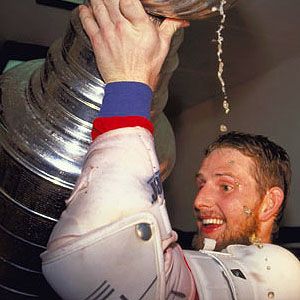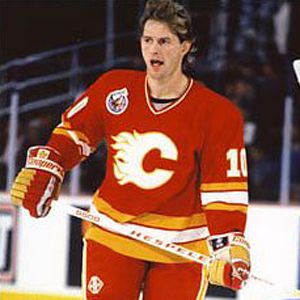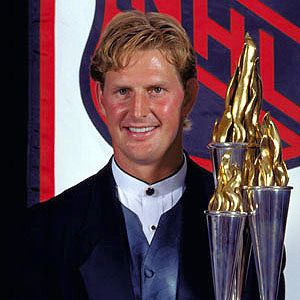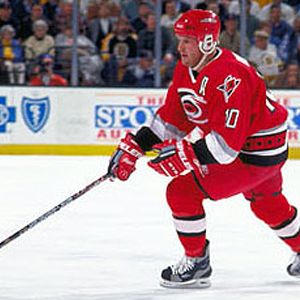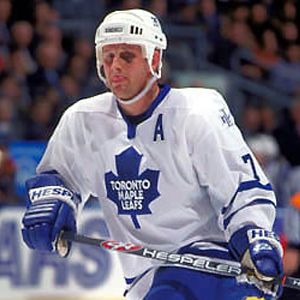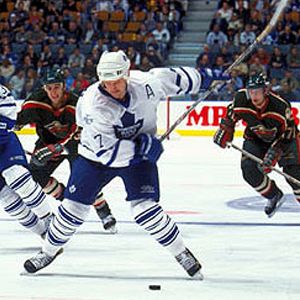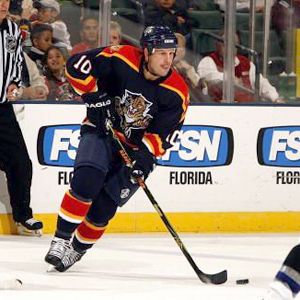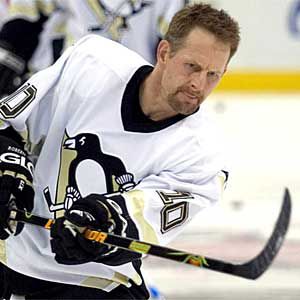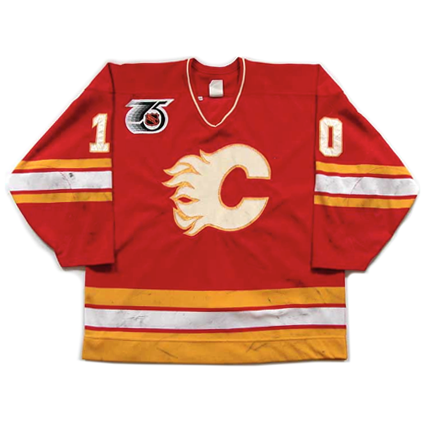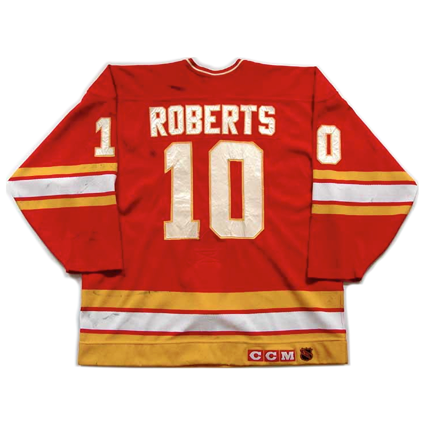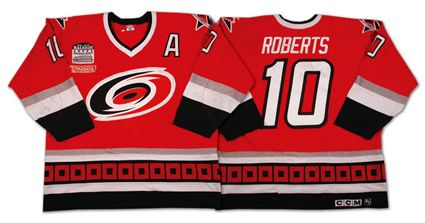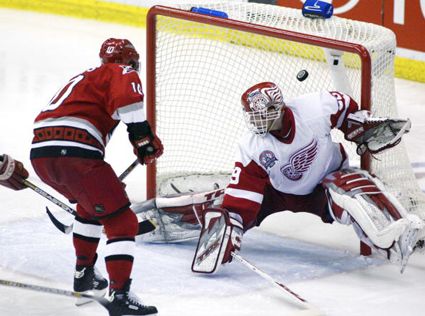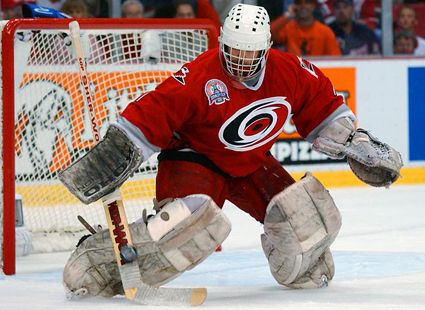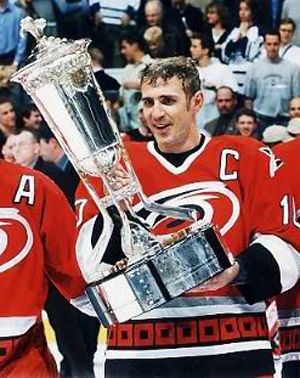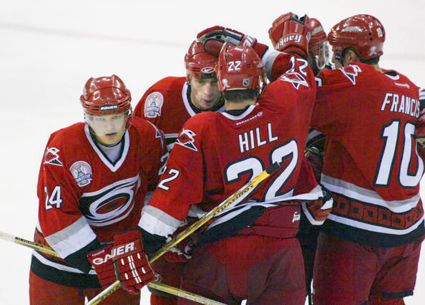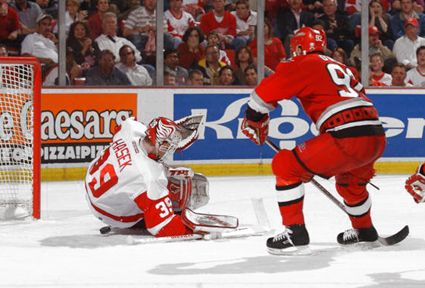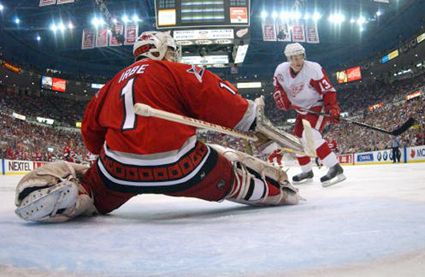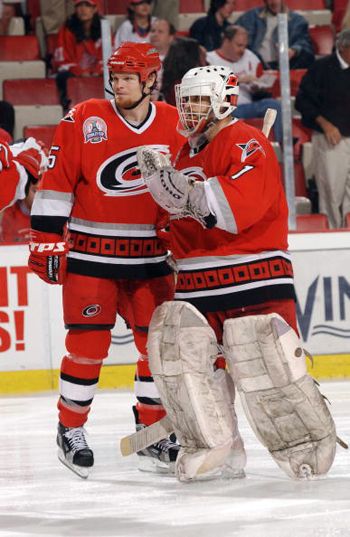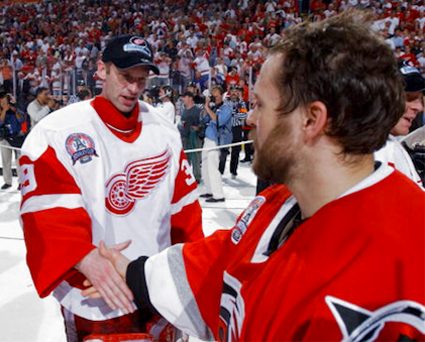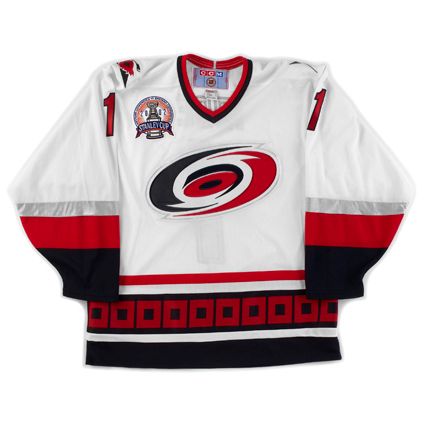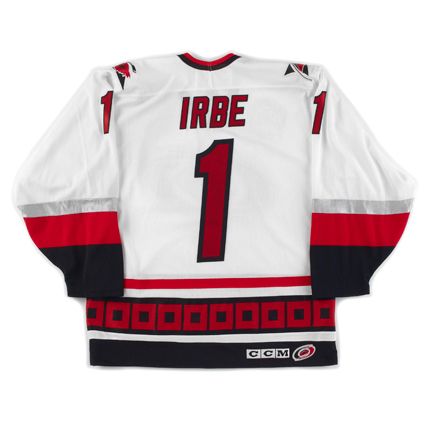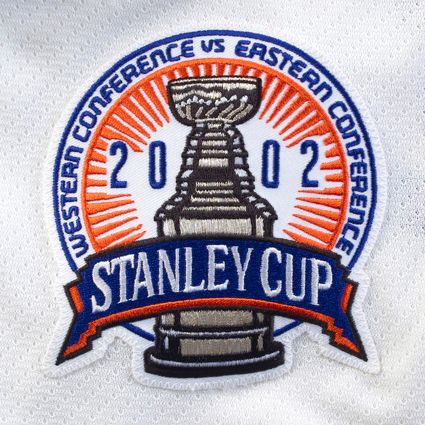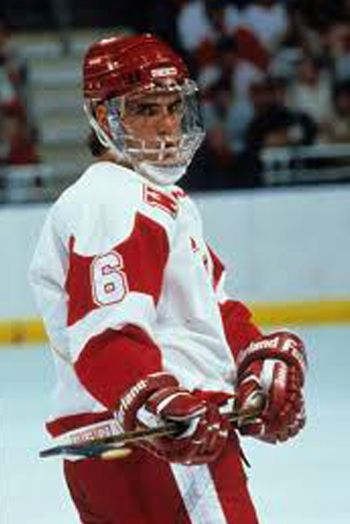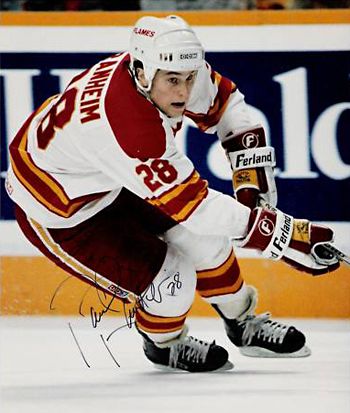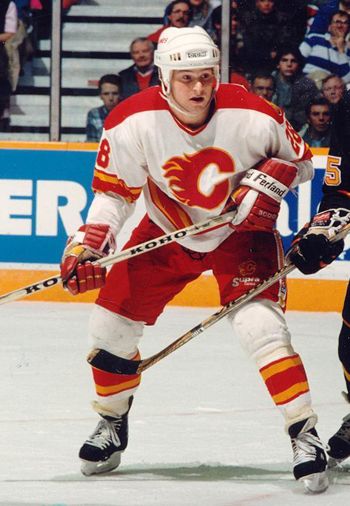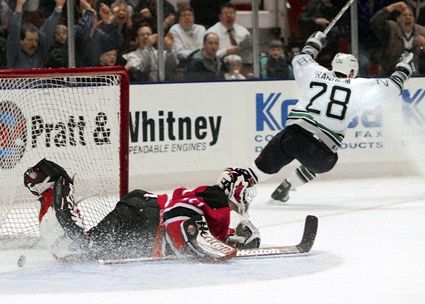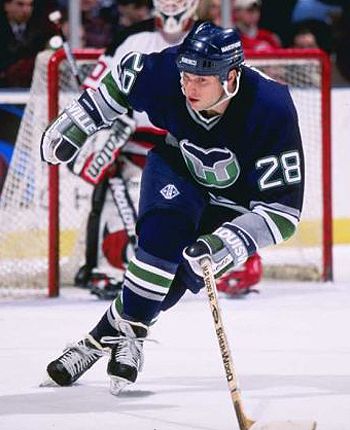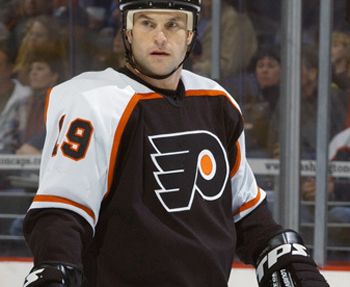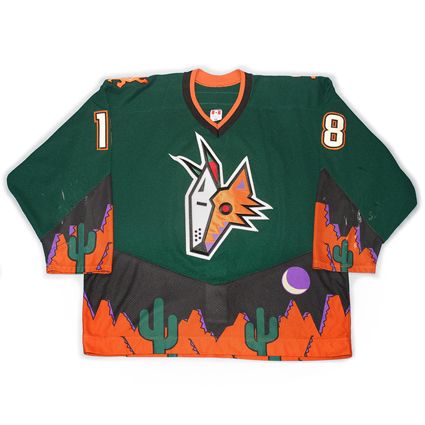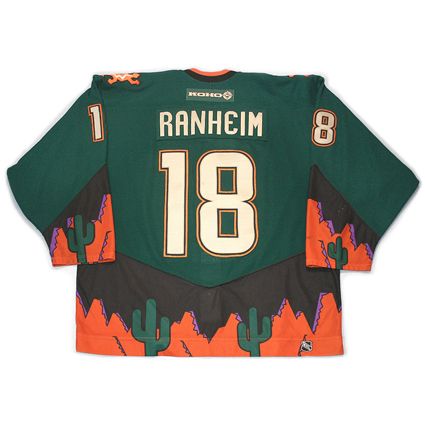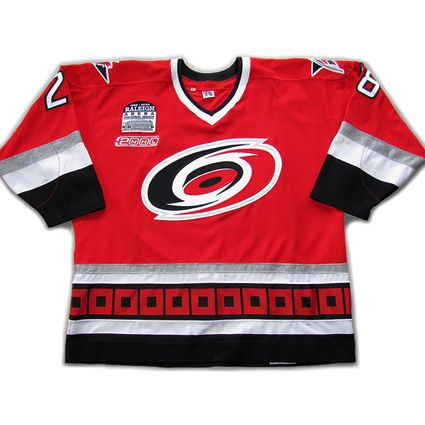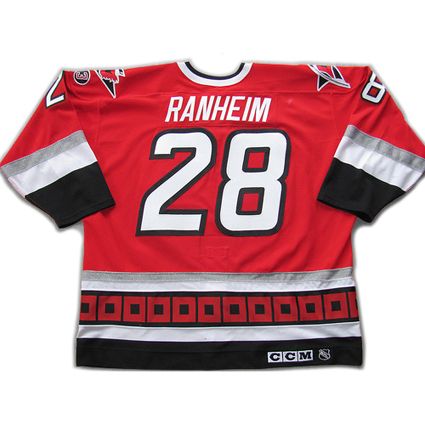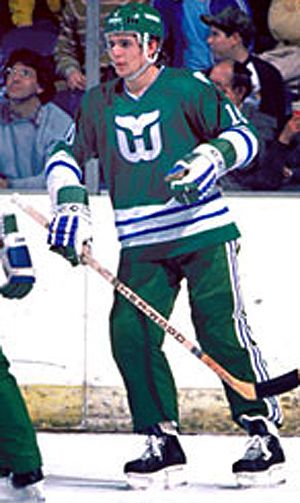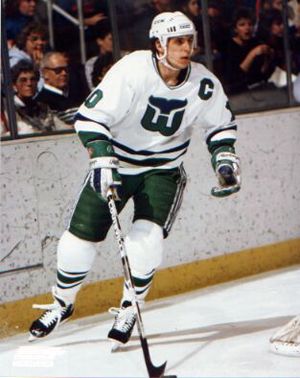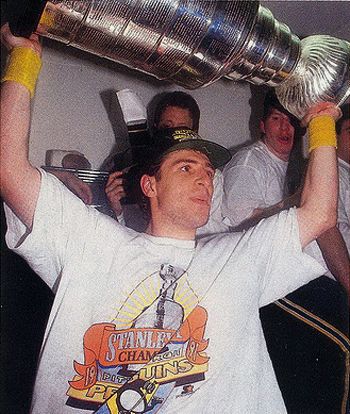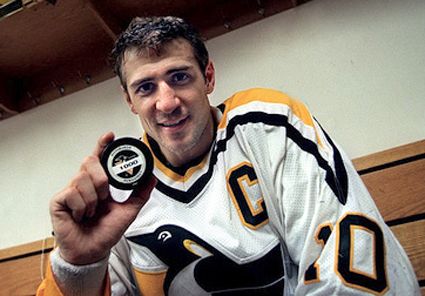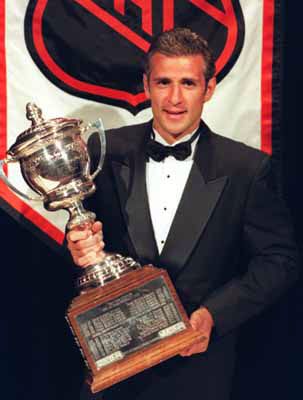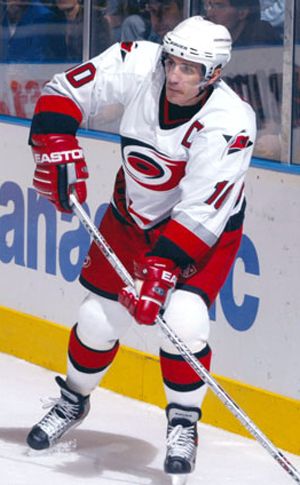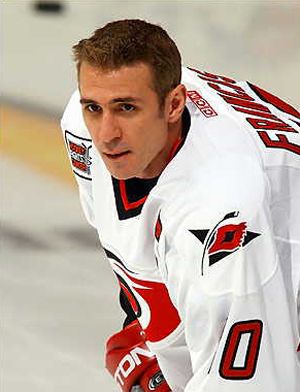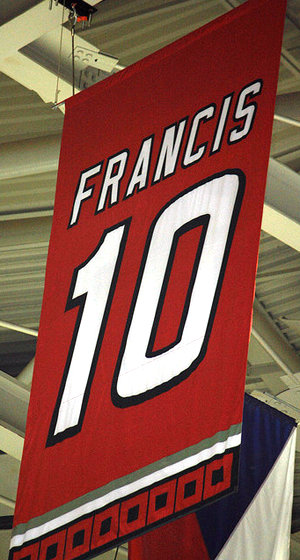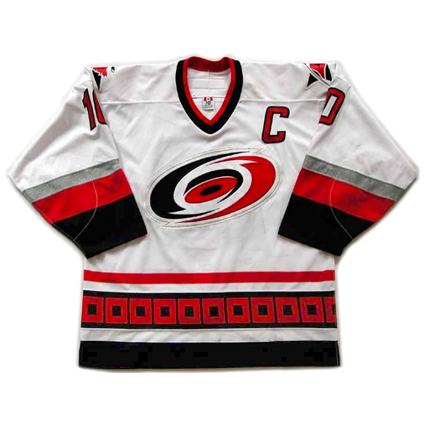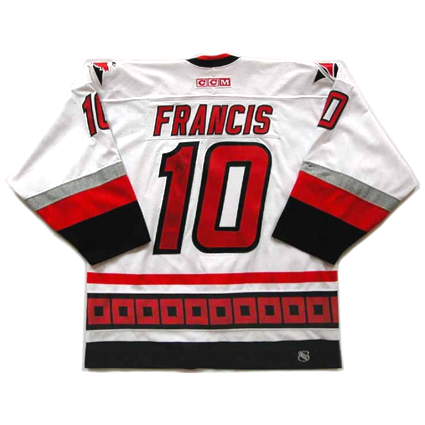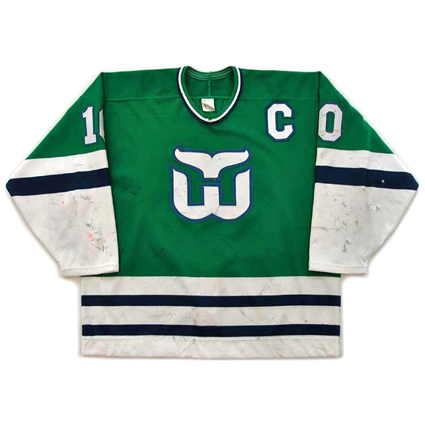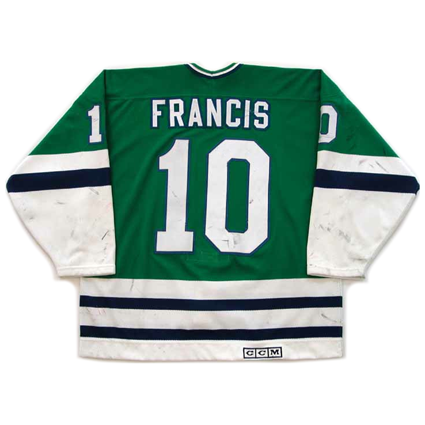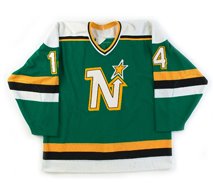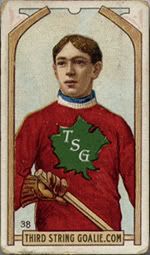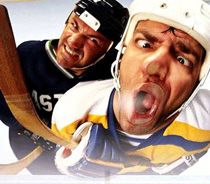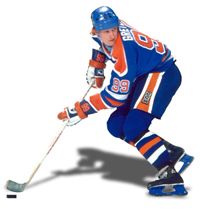- Gary Roberts sleeps with a pillow under his hockey stick
- Gary Roberts goes grocery shopping at Lowe's
- That's not a chin under Gary Roberts playoff beard, it's another fist
Showing posts with label Carolina Hurricanes. Show all posts
Showing posts with label Carolina Hurricanes. Show all posts
Tuesday, May 23, 2017
1991-92 Calgary Flames Gary Roberts Jersey
Gary Roberts, born on this date in 1966, began his road to the NHL with the Ottawa 67's of the OHL in 1982-83. After his second season, in which he scored 57 points in 48 games and impressed with his toughness, acquiring 144 penalty minutes, Roberts was drafted 12th overall in the 1984 NHL Entry Draft. Additionally, Ottawa won the OHL playoff championship and advanced to the Memorial Cup, which they were able to win following a 7-2 dismantling of the Kitchener Rangers in the final.
Now full of confidence after having been drafted as well as winning the championship the previous year, Roberts elevated his game to the next level in 1984-85 when he scored 44 goals and 106 points while amassing 186 penalty minutes in 59 games, establishing himself as an elite NHL prospect.
Roberts began the 1985-86 season with Ottawa bit was traded to the Guelph Platers for the second half of the season. Roberts was the missing piece for Guelph, as he racked up 31 points in 20 playoff games to lead the Paters to the second Memorial Cup title of his career.
Roberts turned professional the next season with the Moncton Golden Flames of the AHL. He was called up to the Calgary Flames, which included scoring a goal in his game. He bounced up and down between the AHL and NHL in 1986-87, eventually totaling 15 points in 32 games with Calgary.
During his second full season with the Flames in 1988-89, Roberts and the Flames went on a run through the playoffs which cumulated in their winning the only Stanley Cup championship in Flames history. In 22 games, Roberts contributed 12 points.
Roberts game took a big leap forward the following season, as he nearly doubled his previous season's offensive totals with 39 goals and 72 points, while his toughness was not affected, as he finished with over 200 penalty minutes for the third of five consecutive seasons.
In 1991-92 Roberts reached the pinnacle of his offensive production with the only 50 goal season of his career with 53 on his way to totaling a career best 90 points to lead the Flames in scoring, no easy feat on a roster with Al MacInnis, Theo Fleury, Sergei Makarov and Joe Nieuwendyk. Thanks to his 207 penalty minutes, Roberts became the first player in NHL history to ever score 50 goals and have over 200 penalty minutes in one season, essentially creating the concept of the modern "power forward" singlehandedly.
In the 1993-94 season Roberts nearly equalled his career high when he hit 84 points in 73 games. During the season he blocked a slapshot while killing a penalty, which broke his thumb in seven places, but in a testament to his ongoing toughness, he missed just one game and scored two goals in his return.
Injuries did get the better of Roberts when he suffered severe nerve damage in his neck, which limited him to just 8 games of the 1994-95 season. His recovery time continued into the 1995-96 season as he require multiple surgeries to address his condition. Finally, he returned in January of 1996 and scored a goal in his first game back. He would play in the Flames next 35 games, changing from center to wing to avoid additional contact for his fragile neck, and score 22 goals and 42 points before once again injuring his neck and missing the remainder of the season as well as the 1996 playoffs.
With the risk of paralysis from any further injury a very real possiblity, Roberts announced his retirement from the NHL in June of 1996, just two days before receiving the Masterton Trophy for his comeback to hockey after nearly a year away earlier in the season.
Roberts never actually signed his retirement papers however, and continued to work out and rehabilitate his neck while missing the 1996-97 season. He announced himself fit and pain free in January of 1997 and was offered a contract by the Flames for the 1997-98 season. Roberts let the Flames know that while he was interested in returning to the NHL, it would be only if he were traded to an Eastern Conference club.
A deal was struck with the Carolina Hurricanes in August and Roberts was able to successfully pass his physical and return to action for the 1997-98 season. He would play three seasons with the Hurricanes, playing 61, 77 and 69 games. He would not return to his previous offensive totals, as his game, as well as the overall style of play in the NHL had changed from the wide open style of his 90 point season eight seasons earlier, but he was still and effective two-way player who consistently scored between 42 and 53 points during the second phase of his career.
Following his three seasons with the Hurricanes, Roberts signed as a free agent with the Toronto Maple Leafs, where his 53 points in 2000-01 were good for second on the club behind perennial leader Mats Sundin while leading the team in hits with 206.
During the 2001-02 playoffs, Roberts led the Maple Leafs with 19 points in 19 games as Toronto made it to the conference finals.
He missed the first four months of the 2002-03 season following shoulder surgeries during the offseason. After playing for a month, he missed another month with a groin injury before returning for the playoffs.
He bounced back with 72 games in 2003-04, which included the 1,000th game of his career on January 13, 2004. That season he was also reunited with former Flames teammate Nieuwendyk.
After sitting out the 2004-05 season due to the NHL lockout rather than playing in Europe like many other NHLers, Roberts, along with Nieuwendyk, signed with the Florida Panthers for the resumption of play for the 2005-06 campaign. His season was limited to 58 games, during which he scored 40 points or more for the 13th time in his career.
During his second season in Florida, Roberts, now 40, was traded to the Pittsburgh Penguins for the remainder of the 2006-07 season.
He returned to Pittsburgh for 2007-08, but suffered a broken leg in December. Known league-wide for his toughness and conditioning, Roberts was said to be listed as "questionable" for the next Penguins game by some fans in jest after hearing the news, along the lines of other such Gary Roberts Facts as;
Roberts season was not finished however, and he returned in time to join the Penguins run to the Stanley Cup Finals.
Following the season, Roberts was traded to the Tampa Bay Lightning where he played in 30 games before retiring for good in March of 2009 after 21 seasons, 438 goals, 910 points, 2,560 penalty minutes and one Stanley Cup and a well earned reputation for toughness, perseverance, fitness and longevity.
Today's featured jersey is a 1991-92 Calgary Flames Gary Roberts jersey worn during the season in which Roberts had his only 50 goal season while setting a career record with 90 points.
The Flames wore this jersey from their first season in Calgary through the 1993-94 season, which included the first nine of Robert's ten seasons with the Flames before changing to a new, more modern style for his final season in Calgary prior to his first retirement following the season due to a serious neck condition.
Bonus Jersey: Today's bonus jersey is a 1999-00 Carolina Hurricanes Gary Roberts jersey as worn during his return to the NHL following his first retirement after returning to action after needing 11 months to recover from serious nerve damage to his neck.
This is a rare "triple patch" jersey, which features both the NHL 2000 patch, worn by all teams in honor of the new millennium, as well as the Raleigh Arena Inaugural Season patch on the front of the jersey. When the Whalers moved out of Hartford, the franchise's new arena would take two years to construct, forcing the team to play their first two seasons as the Hurricanes in Greensboro, an hour and a half from their eventual home in Raleigh.
Completed for the 1999-00 season, the club would now move into their new, permanent home and celebrated the move with a celebratory patch.
Also appearing on this jersey, but obscured from view on the left arm in between the sleeve number and secondary shoulder logo, is the Steve Chaisson Memorial patch, worn in memory of former Hurricane Chaisson who died in an automobile accident just after the conclusion of the previous season.
The Hurricanes have worn this jersey since relocating from Hartford in 1997, even maintaining the essentially the same jersey during the switch to the Reebok Edge jerseys in 2007-08.
In today's video section, the 41-year-old Roberts teaches 23 -year-old Ben Eager a lesson about respect.
In this highlight, Roberts scores in triple overtime to win a playoff game for the Maple Leaf in 2002.
Finally, Roberts wreaking havoc for Pittsburgh during the 2007-08 season. And don't you forget it.
Labels:
Calgary Flames,
Carolina Hurricanes,
Roberts Gary
Saturday, June 4, 2016
2001-02 Carolina Hurricanes Arturs Irbe Jersey
It was on this date in 2002 that the Carolina Hurricanes opened the Stanley Cup finals with a 3-2 overtime victory versus the Detroit Red Wings on a goal by Ron Francis.
The series would feature the first matchup between two European born goaltenders, the Red Wings veteran Czech Dominik Hasek and Carolina's Latvian Arturs Irbe.
The series would feature the first matchup between two European born goaltenders, the Red Wings veteran Czech Dominik Hasek and Carolina's Latvian Arturs Irbe.
Carolina was not expected to be much of a threat to be in the finals. Despite winning the "South-least" Division with 91 points, they had the second lowest point total of any team in the playoffs that season!
Being that they were a division winner, such as it was, they were seeded third in the Eastern Conference rather than seventh, had the seedings been strictly on points. Instead facing the #2 seed, the Hurricanes faced the #6 seeded New Jersey Devils, who they eliminated 4 games to 2. Carolina would advance to the finals by beating the #8 seed, the Montreal Canadiens and the #4 seed, the Toronto Maple Leafs, also by 4-2 margins.
Carolina would fall behind in Game 1 in Detroit after a goal by Sergei Fedorov at 15:21 the first period on a power play, but the Hurricanes would equalize in the 2nd on a goal early in the period from defenseman Sean Hill, also on the power play at the 3:30 mark.
The teams would trade goals later in the second, Kirk Maltby scoring for the Red Wings at 10:39 and Jeff O'Neill countering for the visitors at 19:10.
The third period passed scoreless as regulation ended deadlocked at 2-2 with the teams also even in shots at 25 each.
The teams would trade goals later in the second, Kirk Maltby scoring for the Red Wings at 10:39 and Jeff O'Neill countering for the visitors at 19:10.
The third period passed scoreless as regulation ended deadlocked at 2-2 with the teams also even in shots at 25 each.
Francis' game winning goal came just 58 seconds into overtime from O'Neill and Sami Kapanen, giving Irbe, who had made 23 saves on 25 shots, the victory.
This would prove to be Irbe's one and only Stanley Cup Final victory, as Detroit would go onto win the next four games to capture the cup.
This would prove to be Irbe's one and only Stanley Cup Final victory, as Detroit would go onto win the next four games to capture the cup.
Today's jersey is a 2001-02 Carolina Hurricanes Arturs Irbe jersey. This jersey features the 2002 Stanley Cup Finals patch as worn by all the players on the upper right chest.
The Hurricanes used the same style jerseys since moving to Carolina for the 1998-99 season, which included the transition to the Reebok Edge jerseys in 2007-08 with only minimal changes, until the 2012-13 season - a 15 year run for the Hurricanes original look with their clever and unique hurricane warning flag waist stripe and their excellent italicized names and numbers, which unfortunately did not carry over to their new look.
Here are the highlights of Game 1 of the 2002 Stanley Cup Finals, which features several great saves by Irbe, particularly one which came with the game tied with roughly nine minutes remaining in the third period.
The Hurricanes used the same style jerseys since moving to Carolina for the 1998-99 season, which included the transition to the Reebok Edge jerseys in 2007-08 with only minimal changes, until the 2012-13 season - a 15 year run for the Hurricanes original look with their clever and unique hurricane warning flag waist stripe and their excellent italicized names and numbers, which unfortunately did not carry over to their new look.
Irbe has a great personal story and was a very popular player in both San Jose and Carolina. Here is a glimpse into what made him unique, from making his own repairs to his aged pads and his pride in his Latvian homeland, which included standing up for what he believed in against the might of the Soviet Union at personal and professional risk.
Here are the highlights of Game 1 of the 2002 Stanley Cup Finals, which features several great saves by Irbe, particularly one which came with the game tied with roughly nine minutes remaining in the third period.
Labels:
Carolina Hurricanes,
Irbe Arturs
Sunday, March 6, 2016
2002-03 Phoenix Coyotes Paul Ranheim Jersey
After spending four seasons at the University of Wisconsin, which included being a team captain and All-American, as well as scoring 6 goals and 9 points in 7 games for the United States at the 1986 World Junior Championships, Paul Ranheim spent the 1988-89 season with the Salt Lake Golden Eagles of the International Hockey League, where he had an impressive first professional season scoring 68 goals and 97 points in 75 games which earned him IHL rookie of the year honors. The Golden Eagles then made it to the Turner Cup Finals, where Ranheim chipped in 10 points in 14 games. He also made his NHL debut with five games for the Calgary Flames, who had drafted Ranheim in the second round of the 1984 NHL draft.
He left the minors behind when he joined the Flames full time in 1989-90, scoring 26 goals and 54 points as a rookie, which would prove to be career highs in both categories. After playing all 80 games in 1989-90, The left winger's sophomore season was ruined when he suffered a shattered ankle which caused him to miss half the season. Once Calgary was eliminated from the playoffs, Ranheim extended his season by appearing at the World Championships for the United States, scoring 4 times in 9 games.
He rebounded by playing in all 80 games in 1991-92, which saw him reach the 20 goal mark for the second time with 23. The 1992-93 season saw Ranheim play in all but one of Calgary's 84 games and top 20 goals for the third time with 21.
After 67 games of the 1993-94 season, Ranheim was dealt to the Hartford Whalers as part of a six player deal along with Ted Drury and Gary Suter in exchange for Michael Nylander, James Patrick and Zarley Zalapski going to Calgary.
The move to Hartford had a dramatic effect on his offensive numbers, as he would never again score more than 10 goals in a season for the remainder of his career, but would remain a valuable penalty killer and responsible defensive forward. After four seasons with the Whalers in Hartford, Ranheim relocated with the franchise when they became the Carolina Hurricanes. Following the Whalers final season in Hartford, Ranheim would make his second appearance at the World Championships, scoring twice in 8 games in 1997.
He would rarely miss a game for the remainder of his career, playing 230 our of a possible 246 games over the next three seasons with the Hurricanes, which included a return to the playoffs in 1999, Ranheim's first post season appearance since 1993 with Calgary, owing to the extended poor play of the Whalers
A trade sent him to the Philadelphia Flyers in time for the 2000-01 season. There, his habit of staying in the lineup continued with 159 games out of 164 over the next two seasons, which were extended with playoff appearances in both 2001 and 2002.
His final NHL season of 2002-02 began in Philadelphia but 28 games in, Ranheim was sent back west in a trade that sent him to the Phoenix Coyotes for the final 40 games of his career, which included his 1,000th NHL game on this date in 2003 in a game against the St. Louis Blues.
He would retire with 1,013 games played, 161 goals and 199 assists for 360 points.
Today's featured jersey is a 2002-03 Phoenix Coyotes Paul Ranheim jersey as worn during his 1000th NHL game on this date in 2003. They Coyotes introduced this alternate style for the 1998-99 season and it immediately became of the the strangest jerseys to ever see the ice in an NHL game, as it's eerie, dark landscape and disembodied coyote head logo looked like some sort of drug hallucination in progress!
After it's first season of use, the crest was outlined in sand beginning in 1999-00 to better separate it from the dark green background.
Bonus jersey: Today's bonus jersey is a 1999-00 Carolina Hurricanes Paul Ranheim jersey. This jersey is one of the rare times when a jersey features three different patches at once, as all teams in the NHL wore the NHL 2000 patch in recognition of the Millennium. Carolina then added the Raleigh Arena inaugural season patch and then unfortunately the #3 patch on the left sleeve in memory of Steve Chaisson, who died in an automobile accident following a team party just after the conclusion of the Hurricanes season in the spring of 1999.
The Hurricanes original jerseys get high marks for the italicized names and attractive numbers as well as the clever waist striping made of hurricane warning flags. They also boasted one of the better secondary logos on the league, their tattered flag flying from a bent hockey stick whipped by high winds.
We have often wondered why more teams do not use italicized numbers, as they give the players the appearance of speed even when standing still. During the 1999-00 season, only five teams used italicized numbers, those being Buffalo, Calgary, Carolina, Nashville and Tampa Bay. In 2015-16 that number had shrunk to just two, Calgary and Winnipeg.
The only thing that really bothered us about the Hurricanes jerseys was the main crest, as we always felt we were looking at the underside of the puck because the crest was upside down!
Today's video section are the Top 5 Goals of the Week, featuring a stunning goal by Ranheim.
Ranheim as a member of the Wisconsin Badgers
He left the minors behind when he joined the Flames full time in 1989-90, scoring 26 goals and 54 points as a rookie, which would prove to be career highs in both categories. After playing all 80 games in 1989-90, The left winger's sophomore season was ruined when he suffered a shattered ankle which caused him to miss half the season. Once Calgary was eliminated from the playoffs, Ranheim extended his season by appearing at the World Championships for the United States, scoring 4 times in 9 games.
He rebounded by playing in all 80 games in 1991-92, which saw him reach the 20 goal mark for the second time with 23. The 1992-93 season saw Ranheim play in all but one of Calgary's 84 games and top 20 goals for the third time with 21.
After 67 games of the 1993-94 season, Ranheim was dealt to the Hartford Whalers as part of a six player deal along with Ted Drury and Gary Suter in exchange for Michael Nylander, James Patrick and Zarley Zalapski going to Calgary.
The move to Hartford had a dramatic effect on his offensive numbers, as he would never again score more than 10 goals in a season for the remainder of his career, but would remain a valuable penalty killer and responsible defensive forward. After four seasons with the Whalers in Hartford, Ranheim relocated with the franchise when they became the Carolina Hurricanes. Following the Whalers final season in Hartford, Ranheim would make his second appearance at the World Championships, scoring twice in 8 games in 1997.
Ranheim scoring against Martin Brodeur
He would rarely miss a game for the remainder of his career, playing 230 our of a possible 246 games over the next three seasons with the Hurricanes, which included a return to the playoffs in 1999, Ranheim's first post season appearance since 1993 with Calgary, owing to the extended poor play of the Whalers
A trade sent him to the Philadelphia Flyers in time for the 2000-01 season. There, his habit of staying in the lineup continued with 159 games out of 164 over the next two seasons, which were extended with playoff appearances in both 2001 and 2002.
His final NHL season of 2002-02 began in Philadelphia but 28 games in, Ranheim was sent back west in a trade that sent him to the Phoenix Coyotes for the final 40 games of his career, which included his 1,000th NHL game on this date in 2003 in a game against the St. Louis Blues.
He would retire with 1,013 games played, 161 goals and 199 assists for 360 points.
Today's featured jersey is a 2002-03 Phoenix Coyotes Paul Ranheim jersey as worn during his 1000th NHL game on this date in 2003. They Coyotes introduced this alternate style for the 1998-99 season and it immediately became of the the strangest jerseys to ever see the ice in an NHL game, as it's eerie, dark landscape and disembodied coyote head logo looked like some sort of drug hallucination in progress!
After it's first season of use, the crest was outlined in sand beginning in 1999-00 to better separate it from the dark green background.
Bonus jersey: Today's bonus jersey is a 1999-00 Carolina Hurricanes Paul Ranheim jersey. This jersey is one of the rare times when a jersey features three different patches at once, as all teams in the NHL wore the NHL 2000 patch in recognition of the Millennium. Carolina then added the Raleigh Arena inaugural season patch and then unfortunately the #3 patch on the left sleeve in memory of Steve Chaisson, who died in an automobile accident following a team party just after the conclusion of the Hurricanes season in the spring of 1999.
The Hurricanes original jerseys get high marks for the italicized names and attractive numbers as well as the clever waist striping made of hurricane warning flags. They also boasted one of the better secondary logos on the league, their tattered flag flying from a bent hockey stick whipped by high winds.
We have often wondered why more teams do not use italicized numbers, as they give the players the appearance of speed even when standing still. During the 1999-00 season, only five teams used italicized numbers, those being Buffalo, Calgary, Carolina, Nashville and Tampa Bay. In 2015-16 that number had shrunk to just two, Calgary and Winnipeg.
The only thing that really bothered us about the Hurricanes jerseys was the main crest, as we always felt we were looking at the underside of the puck because the crest was upside down!
Today's video section are the Top 5 Goals of the Week, featuring a stunning goal by Ranheim.
Labels:
Carolina Hurricanes,
Phoenix Coyotes,
Ranheim Paul
Tuesday, March 1, 2016
2000-01 Carolina Hurricanes Ron Francis Jersey
After a junior hockey career with the Sault Ste. Marie Greyhounds, Ron Francis, born on this date in 1963, joined the Hartford Whalers, who drafted him fourth overall in the 1981 NHL Entry Draft.
His offensive production was immediate, as in 59 games of the 1981-82 season he tallied 25 goals and 68 points as a rookie. The following season Francis led the Whalers in scoring after raising his goals to 31 and his points to 90 while being named to his first NHL All-Star Game in 1983. After scoring 83 points in 1983-84, Francis again led Hartford in scoring with 81 points and being named to his second all-star game. After 77 points in 1985-86 as well as being named team captain at the age of just 22, Francis led the Whalers in scoring for the third time in six seasons with a new career high of 93 points while hitting 30 goals for the second time.
Francis while wearing long pants while with the Whalers
A drop back to 75 points in 1987-88 was still enough to lead the Whalers in scoring once again, followed by 77 points the following season. His finest season in Hartford came during the 1989-90 campaign with a career high 32 goals as well as 69 assists for 101 points which earned him a third all-star appearance. His 69 assists were 7th in the league that season.
Francis now as the Whalers captain
After 67 games of the 1990-91 season, Francis stood at 76 points but was then involved in a blockbuster trade, which sent him, Ulf Samuelsson and Grant Jennings to the Pittsburgh Penguins for Jeff Parker, Zarley Zalapski and John Cullen. Centering the Penguins second line, Francis added another 11 regular season points plus 17 playoff points in 24 games as the Penguins captured the Stanley Cup over the Minnesota North Stars.
Francis celebrates the Penguins Stanley Cup championship
Missing ten games of the 1991-92 season was partly responsible for a decline in his scoring, as the finished the season with a career low 54 points, but kept intact his streak of scoring at least 50 points for the 11th consecutive season. Francis stepped upon the postseason though, scoring 27 points in 21 games, ably leading the team while team captain Mario Lemieux missed six games due to injury as the Penguins swept their final two series to capture their second consecutive Stanley Cup.
Francis reached the 100 point mark for the second time in 1992-93 with 24 goals and 76 assists which included his 1,000th career point. He followed that up with another 93 points the following season.
Francis with the puck from his 1,000th NHL point
His streak of consecutive 50 point seasons was put in jeopardy by the abbreviated 48 game 1994-95 season, of which Francis only skated in 44 games. Still, he netted 11 goals and 48 assists to comfortably keep his streak intact with 59 points as well as being named team captain during Lemieux's absence due to injury. In addition to his offensive streak, Francis valuable two-way play was rewarded with his being named the winner of the Selke Trophy as the as the league's best defensive forward and his style of play earned him a second award that season, the first of three Lady Byng Trophies for gentlemanly play.
Francis with the Lady Byng Trophy
The return of Lemieux from missing the previous season shifted the Penguins offense into a higher gear in 1995-96, with Francis racking up 92 assists to tie Lemieux for the league lead and a career high 119 points for fourth overall in the NHL scoring race despite coming in third on his own team! His efforts were recognized with his fourth NHL All-Star appearance.
His final two seasons with Pittsburgh saw Francis once again named team captain following the retirement of Lemieux as he would score 90 and then 87 points as he wrapped up 8 seasons with the Penguins by registering his 1,000th career assist as well as his second Lady Byng Trophy.
For the 1998-99 season, Francis signed as a free agent with the Carolina Hurricanes, who were the original Hartford Whalers franchise, now relocated to North Carolina. Naturally, his offensive production took a hit moving away from the prolific Penguins, and his 52 points were a career low up to that point, but his 50 point streak remained in effect, now at 18 seasons and counting. Francis was also installed as captain of the Hurricanes immediately upon his arrival.
Anyone who thought Francis career was in decline was sorely mistaken, as he rebounded with 73 points to lead the club in scoring. During the 2000-01 season, Francis scored a goal on this date, his 38th birthday, to become just the second player in NHL history to score 50 points for an amazing twenty straight seasons, the other being the legendary Gordie Howe. Francis would finish the season with a total of 65 points.
Francis wearing the Hockey Fights Cancer patch
worn by only each club's captain
worn by only each club's captain
The 2001-02 season saw Francis score 77 points thanks to his third consecutive season with exactly 50 assists. He also joined the exclusive ranks of 500 goal scorers, just the 29th player to reach that plateau. The Hurricanes would go on the best playoff run of the franchise's time in the NHL, reaching the Stanley Cup Finals for the first time thanks in part to Francis' team leading 16 playoff points in 23 games.
Francis with the Prince of Wales Trophy as Eastern Conference champions
He equalled Howe's streak of 50 point seasons in 2002-03 with 57 points, his 22nd consecutive season with 50 points or more.
His final NHL season saw him play 68 games with Carolina before a late season trade to the Toronto Maple Leafs, where he played 12 regular season games and an additional 12 playoff games as Toronto was eliminated in the second round. That final season, between the two clubs combined, Francis scored 13 goals and 27 assists for 40 points, bringing to an end his 50 point streak, as well as his career, as he retired following the season, but not before winning his third Lady Byng Trophy as well as the King Clancy Memorial Trophy in recognition of his leadership on and off the ice.
Francis during his brief time in Toronto
His final career totals are 1,731 games played (third in NHL history), 549 goals scored (26th all-time) and 1,249 assists (2nd only behind Wayne Gretzky) for 1,798 points (4th all-time behind only Gretzky, Mark Messier and Howe).
Francis was honored by having his #10 raised to the rafters at the Hartford Civic Center, being named to the Penguins Ring of Honor and having his #10 formally retired by the Carolina Hurricanes in 2007.
Today's featured jersey is a 2000-01 Carolina Hurricanes Ron Francis jersey as worn the season Francis extended his 50 point streak to 20 seasons, only the second player to accomplish that level of productive longevity.
The Hurricanes adopted this jersey style for their very first season in North Carolina of 1997-98, the best feature of which is the clever hurricane warning flags repeated as the waist stripe. They added a black outline to their one color names after three seasons, but other than that minor tweak to the customizing, the jerseys remained unchanged until the introduction of the new Reebok Edge jerseys in 2007-08. The design remained as true to the original as possible, with really only white piping around the shoulders worth noting.
Bonus jersey: Today's bonus jersey is a 1989-90 Hartford Whalers Ron Francis jersey. Francis best season in Hartford was the 1989-90 season during which he had the first 100 point season of his career.
The Whalers adopted their new jerseys on the occasion of entering the NHL in 1979-80 following the demise of the WHA, their original home. At the time of the Whalers entering the NHL, they changed their color scheme from green and gold to green and blue, as well as changing their name from the New England Whalers to the Hartford Whalers on the insistence of the Boston Bruins.
The W-tail logo was a clever piece of graphic design creating the "H" out of the negative space between the "W" and the tail. This jersey was worn with the controversial long pants during only the 1982-83 season, and one of only two teams to ever sport the long pants look in the NHL.
There were some minor changes to this style over it's lifespan through 1991-92, including the bottom hem below the stripes changing from green to white and the stripes on the arms changing from angled to straight and back again, only to become straight once more. The most unfortunate change in style though, was the elimination of the Pucky the Whale shoulder patches in 1985-86.
Francis Today's featured video is a tribute to Francis and his long and productive career.
Here is an interview with Francis during which he looks back on his career.
Finally, here is Francis speech on the occasion of being inducted into the Hockey Hall of Fame.
Labels:
Carolina Hurricanes,
Francis Ron,
Hartford Whalers
Friday, May 23, 2014
1991-92 Calgary Flames Gary Roberts Jersey
Gary Roberts, born on this date in 1966, began his road to the NHL with the Ottawa 67's of the OHL in 1982-83. After his second season, in which he scored 57 points in 48 games and impressed with his toughness, acquiring 144 penalty minutes, Roberts was drafted 12th overall in the 1984 NHL Entry Draft. Additionally, Ottawa won the OHL playoff championship and advanced to the Memorial Cup, which they were able to win following a 7-2 dismantling of the Kitchener Rangers in the final.
Now full of confidence after having been drafted as well as winning the championship the previous year, Roberts elevated his game to the next level in 1984-85 when he scored 44 goals and 106 points while amassing 186 penalty minutes in 59 games, establishing himself as an elite NHL prospect.
Roberts began the 1985-86 season with Ottawa bit was traded to the Guelph Platers for the second half of the season. Roberts was the missing piece for Guelph, as he racked up 31 points in 20 playoff games to lead the Paters to the second Memorial Cup title of his career.
Roberts turned professional the next season with the Moncton Golden Flames of the AHL. He was called up to the Calgary Flames, which included scoring a goal in his game. He bounced up and down between the AHL and NHL in 1986-87, eventually totaling 15 points in 32 games with Calgary.
During his second full season with the Flames in 1988-89, Roberts and the Flames went on a run through the playoffs which cumulated in their winning the only Stanley Cup championship in Flames history. In 22 games, Roberts contributed 12 points.
Roberts game took a big leap forward the following season, as he nearly doubled his previous season's offensive totals with 39 goals and 72 points, while his toughness was not affected, as he finished with over 200 penalty minutes for the third of five consecutive seasons.
In 1991-92 Roberts reached the pinnacle of his offensive production with the only 50 goal season of his career with 53 on his way to totaling a career best 90 points to lead the Flames in scoring, no easy feat on a roster with Al MacInnis, Theo Fleury, Sergei Makarov and Joe Nieuwendyk. Thanks to his 207 penalty minutes, Roberts became the first player in NHL history to ever score 50 goals and have over 200 penalty minutes in one season, essentially creating the concept of the modern "power forward" singlehandedly.
In the 1993-94 season Roberts nearly equalled his career high when he hit 84 points in 73 games. During the season he blocked a slapshot while killing a penalty, which broke his thumb in seven places, but in a testament to his ongoing toughness, he missed just one game and scored two goals in his return.
Injuries did get the better of Roberts when he suffered severe nerve damage in his neck, which limited him to just 8 games of the 1994-95 season. His recovery time continued into the 1995-96 season as he require multiple surgeries to address his condition. Finally, he returned in January of 1996 and scored a goal in his first game back. He would play in the Flames next 35 games, changing from center to wing to avoid additional contact for his fragile neck, and score 22 goals and 42 points before once again injuring his neck and missing the remainder of the season as well as the 1996 playoffs.
With the risk of paralysis from any further injury a very real possiblity, Roberts announced his retirement from the NHL in June of 1996, just two days before receiving the Masterton Trophy for his comeback to hockey after nearly a year away earlier in the season.
Roberts never actually signed his retirement papers however, and continued to work out and rehabilitate his neck while missing the 1996-97 season. He announced himself fit and pain free in January of 1997 and was offered a contract by the Flames for the 1997-98 season. Roberts let the Flames know that while he was interested in returning to the NHL, it would be only if he were traded to an Eastern Conference club.
A deal was struck with the Carolina Hurricanes in August and Roberts was able to successfully pass his physical and return to action for the 1997-98 season. He would play three seasons with the Hurricanes, playing 61, 77 and 69 games. He would not return to his previous offensive totals, as his game, as well as the overall style of play in the NHL had changed from the wide open style of his 90 point season eight seasons earlier, but he was still and effective two-way player who consistently scored between 42 and 53 points during the second phase of his career.
Following his three seasons with the Hurricanes, Roberts signed as a free agent with the Toronto Maple Leafs, where his 53 points in 2000-01 were good for second on the club behind perennial leader Mats Sundin while leading the team in hits with 206.
During the 2001-02 playoffs, Roberts led the Maple Leafs with 19 points in 19 games as Toronto made it to the conference finals.
He missed the first four months of the 2002-03 season following shoulder surgeries during the offseason. After playing for a month, he missed another month with a groin injury before returning for the playoffs.
He bounced back with 72 games in 2003-04, which included the 1,000th game of his career on January 13, 2004. That season he was also reunited with former Flames teammate Nieuwendyk.
After sitting out the 2004-05 season due to the NHL lockout rather than playing in Europe like many other NHLers, Roberts, along with Nieuwendyk, signed with the Florida Panthers for the resumption of play for the 2005-06 campaign. His season was limited to 58 games, during which he scored 40 points or more for the 13th time in his career.
During his second season in Florida, Roberts, now 40, was traded to the Pittsburgh Penguins for the remainder of the 2006-07 season.
He returned to Pittsburgh for 2007-08, but suffered a broken leg in December. Known league-wide for his toughness and conditioning, Roberts was said to be listed as "questionable" for the next Penguins game by some fans in jest after hearing the news, along the lines of other such Gary Roberts Facts as;
- Gary Roberts sleeps with a pillow under his hockey stick
- Gary Roberts goes grocery shopping at Lowe's
- That's not a chin under Gary Roberts playoff beard, it's another fist
Roberts season was not finished however, and he returned in time to join the Penguins run to the Stanley Cup Finals.
Following the season, Roberts was traded to the Tampa Bay Lightning where he played in 30 games before retiring for good in March of 2009 after 21 seasons, 438 goals, 910 points, 2,560 penalty minutes and one Stanley Cup and a well earned reputation for toughness, perseverance, fitness and longevity.
Today's featured jersey is a 1991-92 Calgary Flames Gary Roberts jersey worn during the season in which Roberts had his only 50 goal season while setting a career record with 90 points.
The Flames wore this jersey from their first season in Calgary through the 1993-94 season, which included the first nine of Robert's ten seasons with the Flames before changing to a new, more modern style for his final season in Calgary prior to his first retirement following the season due to a serious neck condition.
Bonus Jersey: Today's bonus jersey is a 1999-00 Carolina Hurricanes Gary Roberts jersey as worn during his return to the NHL following his first retirement after returning to action after needing 11 months to recover from serious nerve damage to his neck.
This is a rare "triple patch" jersey, which features both the NHL 2000 patch, worn by all teams in honor of the new millennium, as well as the Raleigh Arena Inaugural Season patch on the front of the jersey. When the Whalers moved out of Hartford, the franchise's new arena would take two years to construct, forcing the team to play their first two seasons as the Hurricanes in Greensboro, an hour and a half from their eventual home in Raleigh.
Completed for the 1999-00 season, the club would now move into their new, permanent home and celebrated the move with a celebratory patch.
Also appearing on this jersey, but obscured from view on the left arm in between the sleeve number and secondary shoulder logo, is the Steve Chaisson Memorial patch, worn in memory of former Hurricane Chaisson who died in an automobile accident just after the conclusion of the previous season.
The Hurricanes have worn this jersey since relocating from Hartford in 1997, even maintaining the essentially the same jersey during the switch to the Reebok Edge jerseys in 2007-08.
In today's video section, the 41-year-old Roberts teaches 23 -year-old Ben Eager a lesson about respect.
In this highlight, Roberts scores in triple overtime to win a playoff game for the Maple Leaf in 2002.
Here is Gary Roberts wreaking havoc for Pittsburgh during the 2007-08 season. And don't your forget it.
We're not saying Roberts played for a long time and was really, really tough, but here he is fighting NHL career penalty minute leader Tiger Williams in 1987. We're just sayin'...
Labels:
Calgary Flames,
Carolina Hurricanes,
Roberts Gary
Subscribe to:
Posts (Atom)

